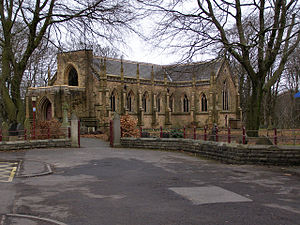- St Stephen and All Martyrs' Church, Lever Bridge
-
St Stephen and All Martyrs' Church,
Lever Bridge
The church from the southwestLocation in Greater Manchester Coordinates: 53°34′20″N 2°24′18″W / 53.5722°N 2.4051°W OS grid reference SD 732 084 Location Little Lever, Bolton,
Greater ManchesterCountry England Denomination Anglican Churchmanship Open Catholic Website St Stephen and All Martyrs History Consecrated 26 June 1845 Architecture Status Parish church Functional status Active Heritage designation Grade II* Designated 26 March 1964 Architect(s) Edmund Sharpe Architectural type Church Style Gothic Revival Groundbreaking 1842 Completed 1844 Construction cost £2,600 (£210,000 as of 2011)[1] Specifications Materials Terracotta, slate roofs Administration Parish Lever Bridge Deanery Walmsley Archdeaconry Bolton Diocese Manchester Province York Clergy Vicar(s) Revd Susan Edwards St Stephen and All Martyrs' Church, Lever Bridge, is in Little Lever, Bolton, Greater Manchester, England. It is an active Anglican parish church in the deanery of Walmsley, the archdeaconry of Bolton, and the diocese of Manchester.[2] The church has been designated a Grade II* listed building by English Heritage,[3] and is the first of three "pot churches" designed by Edmund Sharpe, so-called because they are constructed largely of terracotta.[4]
Contents
History
The church was built between 1842 and 1844 to a design by the Lancaster architect Edmund Sharpe. It is built mainly in terracotta made by the local firm of the Ladyshore Coal and TerraCotta Company, which was owned by Sharpe's brother-in-law, John Fletcher. There were problems in firing the terracotta resulting in considerable wastage but, despite this, the church cost only £2,600 (£210,000 as of 2011)[1] to build.[4] The church was formally opened on 18 February 1844, and consecrated on 26 June 1845 by Rt Revd John Bird Sumner, the Bishop of Chester. Originally the church had a spire, with crocketed pinnacles, a parapet with open tracery, and traceried windows.[5] By the 1930s the spire had become unsafe, and it was dismantled in 1937. There had been plans to rebuild it, but the lower part of the tower was dismantled by the local steeplejack Fred Dibnah in 1966.[5] Following the discovery of extensive dry rot in 1989 a programme of repairs, including the removal of the dry rot, has been undertaken.[2]
Architecture
Exterior
Other than the slate roof, all the visible fabric of the church is terracotta, the use of which material has allowed for a high degree of decoration.[4] The plan of the church is cruciform, consisting of a nave with a west porch (the original base of the tower), two wide transepts, a short chancel, and a vestry in the angle between the north transept and chancel. Externally the nave is divided into five bays by buttresses which are surmounted by finials. Each bay contains a two-light window in Decorated style. The transepts and chancel are similarly divided, with four-light Decorated windows at their ends. Along the top runs an openwork parapet.[3]
Interior
Internally the timber hammerbeam roof is carried on terracotta corbels. There is much decoration, with friezes, ball-flowers, foliage, inscriptions, panels, and blind arcades, all in terracotta.[3] Behind the altar, forming a reredos, are niches, and panelling incorporating the words of the Ten Commandments, the Creed, and the Lord's Prayer. Terracotta also forms the pew ends, which are decorated with poppy heads, and the organ case. The original altar, the octagonal diapered font and pulpit were also in terracotta. The stained glass in the east window, and in some of the windows elsewhere in the church, is by Thomas Willement; one of these windows depicts the execution of Charles I. A window in the south transept is by William Wailes and shows the stoning of Saint Stephen; and one of the windows in the north transept was designed by Henry Holiday in 1884.[4][5]
Context and assessment
Although terracotta was to become a frequently used building material, particularly in the industrial North of England, it was rarely used for churches. The only churches to be built with this material were the three designed by Sharpe, the others being Holy Trinity, Rusholme, and St Paul's, Scotforth. Its use in St Stephen's has been described as "part experiment, part advertisement".[4] Critical reaction at the time it was built varied from the Illustrated London News, who called it a "truly elegant structure", and the Ecclesiologist, who considered its decoration to be "pretense and affected".[6] Today the Buildings of England series states that "the interior is exceptionally pretty",[6] and National Heritage List for England, referring to the terracotta, states it is "a remarkable demonstration of the capabilities of the material".[3]
See also
- List of architectural works by Edmund Sharpe
- Grade II* listed buildings in Greater Manchester
References
- ^ a b UK CPI inflation numbers based on data available from Lawrence H. Officer (2010) "What Were the UK Earnings and Prices Then?" MeasuringWorth.
- ^ a b St Stephen & All Martyrs, Bolton, Church of England, http://www.achurchnearyou.com/lever-bridge-st-stephen-all-martyrs/, retrieved 17 June 2010
- ^ a b c d "Church of St Stephen and All Martyrs, Bolton", The National Heritage List for England (English Heritage), 2011, http://list.english-heritage.org.uk/resultsingle.aspx?uid=1388051, retrieved 17 May 2011
- ^ a b c d e Hartwell, Clare; Hyde, Matthew; Pevsner, Nikolaus (2004), Lancashire: Manchester and the South-East, The Buildings of England, New Haven and London: Yale University Press, pp. 157–158, ISBN 0-300-10583-5
- ^ a b c Hughes, John M. (2010), Edmund Sharpe: Man of Lancaster, John M. Hughes, pp. 247–258
- ^ a b Quoted in Hartwell, Clare; Hyde, Matthew; Pevsner, Nikolaus (2004), Lancashire: Manchester and the South-East, The Buildings of England, New Haven and London: Yale University Press, p. 157, ISBN 0-300-10583-5
Categories:- Grade II* listed churches
- Church of England churches in Greater Manchester
- Grade II* listed buildings in Greater Manchester
- Gothic Revival architecture in England
- Religious buildings completed in 1844
- 19th-century Anglican church buildings
- Anglican Diocese of Manchester
- Edmund Sharpe buildings
- Terracotta
Wikimedia Foundation. 2010.

